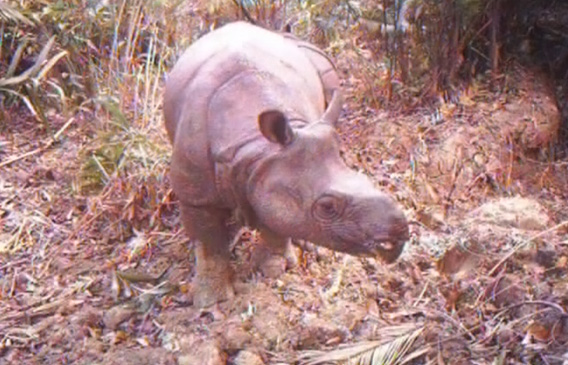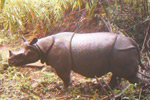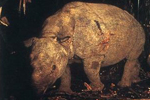
One of the last Javan rhinos captured by a camera trap in Ujung Kulon. WWF, the International Rhino Foundation, and the Aspinall Foundation have supplied the park with more than 100 camera traps. Video capture courtesy of Ujung Kulon National Park.
August 27, 1883. It’s been called “the day the world exploded.” One hundred and thirty years ago this month, the volcanic island of Krakatau (Krakatoa) blew its top. The smoking mountain had given several days warning to the human inhabitants of Java and Sumatra, the closest large islands, but no one could have imagined the intensity of the eruption and the devastation that followed.
Several cubic miles of rock and ash – more than half the island – rocketed skyward. The explosion released over 10,000 times the energy of the atomic bomb dropped on Hiroshima and was an order of magnitude more powerful than the eruption of Mount St. Helens. Its sound carried as far as India and Australia. More than 150 villages and towns were destroyed, with nearly 40,000 people losing their lives. Tsunamis greater than 100 feet high roared over coastal habitats, inundating lowland forests and scouring them of wildlife.
 Present-day Anak Krakatau. Photo taken by Inov, IRF’s Indonesia Liaison |
Western Java’s Ujung Kulon peninsula lies south of Krakatau across the Sunda Strait. All of its human inhabitants perished as a result of the eruption, as did resident populations of two of the world’s rarest mammals – the Javan tiger and the Javan rhinoceros. Their only safe haven would have been Gunung Payung, a mountain on the peninsula’s extreme western tip, or the highlands of Gunung Honje to the east, but survivors would have been few.
A century later, Indonesia declared Ujung Kulon a national park. Humans never re-settled the peninsula, but the tigers and rhinos did. Poaching ultimately drove the Javan tiger to extinction. The rhinos, however, have managed to hang on by a slim thread. Thanks to intensive protection efforts, a population of perhaps 50 animals remains today, but these are the last Javan rhinos on the planet. A species that once ranged from the foothills of the Himalayas, through mainland Southeast Asia and onto the islands of Sumatra and Java – a distribution that spans over 3,000 miles – is now apparently gone forever from India, Bangladesh, Myanmar, Laos, Thailand, Malaysia, Cambodia, China and Vietnam.
Meanwhile, an insidious new volcano grows from the remnants of the old. Anak Krakatau (Child of Krakatau) began life on the sea floor sometime after the historic eruption, breaking the surface in the late 1920s. Its peak now stands higher than 1,000 feet, and the new volcano grows at the rate of 15 feet or more each year. Oh, and yes, Anak Krakatau is active and could erupt again someday, just as its daddy did. How ironic is it that the only place on Earth left for Javan rhinos is also the most threatened real estate in which they have ever lived?
 Javan rhino coastal habitat |
Certainly this creature deserves the status of Critically Endangered assigned to it by the IUCN Red List of Threatened Species. Yet all is not necessarily doom and gloom. The Ujung Kulon rhino population appears to have stabilized at somewhere between 40 and 50 individuals. In fact, recent video camera-trap studies confirm the presence of 35 distinguishable animals, including at least four calves still in the company of their mothers. Wildlife conservationists would not have predicted these numbers fifty years ago. At the time, estimates of Javan rhinos inhabiting Ujung Kulon were two to three dozen at most, and the prognosis for survival was poor. According to German zoologist and filmmaker, Eugen Schuhmaker, who visited the area in 1967 and produced both a book and a documentary entitled The Last Paradises: On the Track of Rare Animals, “In my opinion the present management of this wildlife reserve is completely inadequate. It is only occasionally that a ranger comes from a distance to visit it; there is no permanent watching station or resident ranger. The few installations previously built by the Dutch have fallen to bits, as have everything else which was once provided by man for the protection of the animals in this area.” Renowned aviator Charles Lindbergh also visited the region in 1967 and wrote the following to the editor of Life magazine, “The Udjong Kulon, hanging geographically by a thread to the western tip of Java, symbolizes the desperation of many of our planet’s animals. In it the life-and-death battle for survival of a distinct species of rhinoceros is being fought.” Neither Schuhmaker nor Lindbergh ever laid eyes on a Javan rhino during their visits. Following receipt of Lindbergh’s letter, Life sent writer/photographer Eliot Elisofon on assignment, but he was also unsuccessful despite spending three months searching for rhinos. However, all three did help draw attention to the plight of this once widespread species.
 Ujung Kulon National Park billboard |
Question: From what does a one- to two-ton, tank-like beast need protection? Answer: From the same poachers that hunted down and killed the last of Java’s tigers for their pelts, meat, bones, claws and whiskers.
Poachers, however, don’t kill rhinos for assorted body parts. They kill them almost exclusively for their horns, agglutinated masses of hair that sit atop the rhino’s snout and can fetch enormous sums in Asian markets for their use in traditional medicine, as fever reducers, or simply as status symbols. The Javan rhino has the smallest horn of all five living species, the average measuring less than a foot in length, and only the adult males sport them. Based on that, one might assume that poaching would not pose a significant threat to survival, but one would be wrong. While it’s true that habitat loss has probably played as much as, if not a greater role in the Javan rhino’s overall decline, poaching could easily deal the species its final blow.

RPUs patrolling Cigunter River
Fortunately, serious protection efforts were put in place in Ujung Kulon at the end of the last century. Privately-funded Rhino Protection Units (RPUs) were added to the Ministry of Forestry’s core teams of forest rangers, who work under the supervision of current park director Mohammad Haryono. The RPU teams are managed by the Rhino Foundation of Indonesia (Yayasan Badak Indonesia or YABI), while the bulk of funding for their salaries, equipment and logistics coming from the International Rhino Foundation (IRF). The IRF relies on grants and contributions from a wide variety of sources in order to maintain RPU programs in three Indonesian national parks – Ujung Kulon, Bukit Barisan Selatan and Way Kambas. The latter two protected areas are crucial to survival of the Sumatran rhino, of which no more than one hundred are believed to exist.

Bill Konstant with a Javan rhino statue
Last July, I spent just over a week in Ujung Kulon, hoping to observe a wild Javan rhino. I was led by IRF’s Indonesian liaison, Inov, who has been studying this species for the last 10 years, and by Sorhim, an RPU team member who has been protecting these creatures for even longer. Sorhim’s job puts him in the field for two to three weeks every month, where he and his team search for snares and traps, as well as rhino signs – footprints, wallows, dung, urine, toppled saplings, nibbled leaves and the very, very occasional direct sighting. During our time hiking the peninsula, we neither saw nor heard a rhino, but we did come across signs of what appeared to be eight distinct individuals. That would be roughly 20% of the estimated population and had me scratching my head as to how these bulky beasts could remain hidden. My only consolation: it wasn’t personal. Let the records show that four Ujung Kulon RPU teams – that’s 16 men – logged a collective total of nearly 3,650 kilometers on patrol in 2012 – roughly the equivalent of hiking from New York City to Las Vegas, Nevada – without one of them spying a live rhino the entire year.
During Inov’s 10 years of visiting Ujung Kulon several times a year, he’s only seen a Javan rhino once. His research involves plants that rhinos do and do not eat. Javan rhinos consume leaves, twigs and fruit, and biologists have identified more than 300 different species that comprise their diet. One plant that offers them zero nutrition is an invasive palm that goes by the Latin name of Arenga obtusifolia and is known locally as langkap. Unfortunately, it has come to dominate the Ujung Kulon landscape and is effectively crowding out a number of important food plants. In fact, it may be the principal factor that limits the habitat’s carrying capacity for Javan rhinos. If large stands of the Arenga palm could be replaced by patches of more edible vegetation, the current theory is that rhinos will increasingly frequent the new “salad bars” and their numbers will grow. This postulate is being tested in a 10,000-acre forest tract connected by a narrow isthmus to the Ujung Kulon peninsula. Its lowland forests surround the foothills of Gunung Honje (Ginger Mountain), and are themselves bordered by rice paddies and an outlying wall of human habitation. The tract is known as the Javan Rhino Study and Conservation Area (JRSCA).
 Javan rhino wallow (left), Clearing Arenga palm (top), Post-clearance vegetative regrowth (bottom).
Javan rhino wallow (left), Clearing Arenga palm (top), Post-clearance vegetative regrowth (bottom).
Approximately 100 acres of experimental plots have already been cleared of palms in JRSCA. Each acre has been cut by local laborers, many of them the same people who were relocated from illegal settlements within the national park a couple of years ago. They use machetes and axes to fell the trees, hack them into manageable pieces, and then drag and stack them along the forest edge. With the dense shade of the palms fronds gone, sunlight strikes the forest floor, stimulating the growth of dormant seeds, runners and roots. New plants quickly appear, and some of the seedlings can reach waist to chest height in only a matter of months. And what’s really encouraging is that more than 90% of the species that recolonize the cleared lands are Javan rhino food plants.
 Widodo Ramono, Executive Director of YABI |
Widodo Ramono is the executive director of YABI, responsible for both protection and research efforts focused on the Javan rhino. He’s also has more history with this creature than anyone else on the planet. Widodo guided Charles Lindbergh when he visited Ujung Kulon in 1967, and was later named director of the national park. His name is prominent on the recovery plans for this species. According to Widodo, JRSCA represents the best hope for the Javan rhino’s survival. He explains, “By expanding the distribution of the Javan rhino, we will not only increase its population, but we will be able to study it more closely. We will learn more about its ecology and behavior, which will help us find a second home within its former range. It is no good, as people say, to have all the eggs in one basket. The same is true for the Javan rhino. If Ujung Kulon is the only place for it to live, the species may not survive.”
The effort to identify a site that could harbor a second, insurance population of Javan rhinos is already underway. Several of Java’s remaining lowland forest tracts have been evaluated, but none appear to be of suitable size. Since the species formerly occurred on Sumatra, a handful of sites on that island warrant consideration. By the time rhino numbers increase in Ujung Kulon, wildlife conservationists hope to identify a second home and have plans in place for what will be an historic reintroduction. The fact that the species has held on this long – no more than 50 animals for nearly the last 50 years – is testament to its tenacity.
AUTHOR: Bill Konstant is a Program Officer at the International Rhino Foundation
Related articles

(06/04/2012) Trekking through deep mud and sawgrass we find a stinking wallow. The elite rangers, dressed completely in black despite the tropical heat, mark the site with the GPS unit, measure the mucky puddle’s depth, and move on. This is the first sign of one of the planet’s rarest animals—the Javan rhino. Only 35 or so remain, including none in captivity. This patch of rainforest and swamp in Ujung Kulon National Park—on the very tip of West Java—is their last and only refuge.
New video documents nearly all the world’s remaining Javan rhinos
(05/01/2012) Nearly all the world’s remaining Javan rhino have been documented on video via camera traps in Indonesia’s Ujung Kulon National Park, according to a montage put together by park authorities.
Down to 50, conservationists fight to save Javan Rhino from extinction

(05/17/2011) Earlier this year, the International Rhino Foundation launched Operation Javan Rhino to prevent the extinction of the critically endangered Javan Rhinoceros (Rhinoceros sondaicus), formerly found in rain forests across Southeast Asia. Operation Javan Rhino is a multi-layered project which links field conservation, habitat restoration, and management efforts with the interests of local governments and communities. The following is an interview with Susie Ellis, Executive Director of the International Rhino Foundation.







